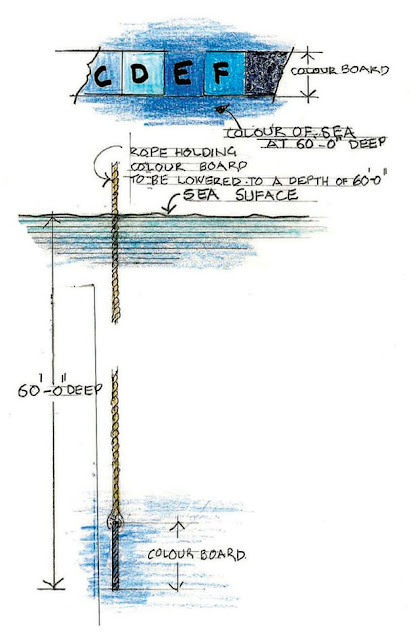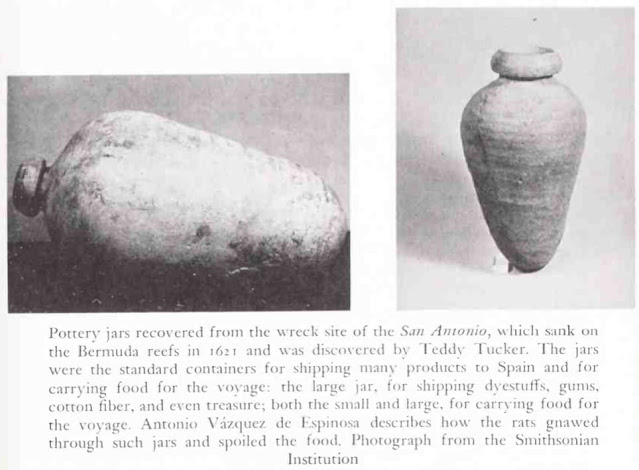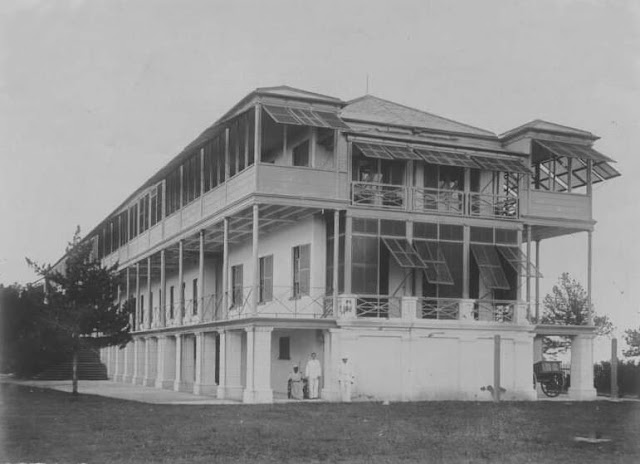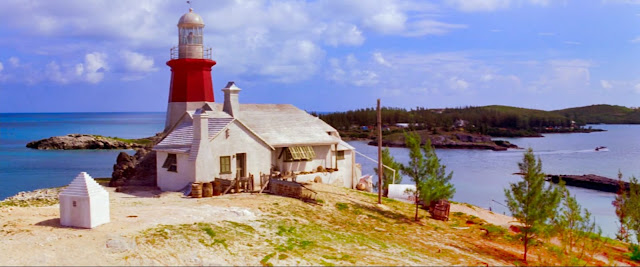Where was the Moray eel from THE DEEP filmed?
Almost all of the scenes inside the wreck of Goliath, including the eel, were filmed at the world's Biggest Underwater Set (BUS), a purpose built underwater soundstage at Ireland Island South, Bermuda.
 |
| The BUS looking west from above The Lagoon (Source Sony Pictures) |
The location has no specific postal address but lies on top a hill once called "Hospital Island" above a private home at 17 Malabar Rd, Sandys MA 01, Bermuda.
There is a secret buried at the summit of Lagoon Road and Heydon Road. Most who pass by never notice the crumbling narrow driveway that disappears into the forest. The entry seems to go nowhere and the old stone wall unfurls all the way down to the Great Sound.
But this mysterious place has one of the most layered histories in all of Bermuda. Remnants of the past continue to reveal themselves including traces of a long gone Royal Naval Hospital and The Deep underwater soundstage.
 |
| 1976 - The Deep BUS on the hill formerly known as Hospital Island with The Lagoon far right. The contemporary Hospital Island is in the foreground bottom of picture (Source Sony Pictures). |
THE DEEP began filming in Bermuda in August 1976 as filming finished at the British Virgin Islands on the wreck of RMS Rhone. Production Designer Tony Masters suggested building an underwater set on land because filming all of the interior scenes at RMS Rhone would take too long. Diving on RMS Rhone at up to 80-feet deep, meant filming was limited to 2-3 dives per day of 30-40 minutes each, with around the same amount of time spent at decompression stops before surfacing (Box Office, 2 May 1977). Filming in a set only 30-feet deep meant that decompression stops would not be necessary and filming time was effectively unlimited.
 |
| Diving on RMS Rhone at up to 80 feet deep plus decompression stops limited filming to less than 2 hours per day (Source American Cinematographer) |
Masters and Art Director Jack Maxsted designed a world-first one million gallon seawater soundstage which was a giant pool measuring 108 feet long1 , 80 feet wide, and 30 feet deep. An early plan appears in the memoir of Underwater Art Director Terry Ackland-Snow.
 |
| Tony Masters' and Jack Maxsted's plan for the BUS (Source Terry Ackland-Snow The Art of Illusion) |
Building on the summit at Lagoon and Heydon Roads meant the soundstage would be above sea-level which stopped brackish water rising upwards into the set. The pool was shaped like an oval dish with sloping sides so that the tons of water would naturally reinforce the walls, and, the interior would give the illusion of visual infinity like the real ocean.
 |
| (Source American Cinematographer March 1977) |
Life began to imitate art when the cavity was lined with polyurethane. Early in Peter Benchley's novel David Sanders contemplated how the ocean filters out colour the deeper one dives.
"In sea water more than a few feet deep, blood is green. Water filters the light from above, seeming to consume the colors of the spectrum shade by shade. Red is the first to succumb, to disappear. Green lasts longer. But then, below 100 feet, green, too, fades away, leaving blue. In the twilight depths -180, 200 feet, and beyond-blood looks black."
The following clip from Kendall Roberg demonstrates how colour is lost the deeper one dives.
The Deep had already shot footage at 60 feet above RMS Rhone before moving to the BUS where the depth was a maximum of 30 feet. This created the potential problem of scenes edited together from the different locations having different ocean colour. Terry Ackland-Snow's ingenious solution was to lower a colour board, painted different shades of blue, 60 feet into the sea. The shade of blue which disappeared at 60 feet was chosen as the correct colour to paint the walls of the BUS.
 |
| Terry Ackland Snow's ocean colour board (Source Terry Ackland-Snow The Art of Illusion) |
Prefabricated sections of Goliath and Grifon were carefully lowered into position and workmen finished building out the interior
 |
| Lifting the Goliath set into the BUS (Source Sony Pictures). |
 |
| A workman finishes the eel's lair set which can be seen behind the eel in the film (Source Sony Pictures). |
Finally the BUS was filled with one million gallons of fresh Atlantic sea water.
 |
| Tony Master's BUS containing the interior of Goliath and Grifon (Source Skin Diver Magazine) |
The BUS was a live marine environment filled with (depending on different reports) 1000 or 4000 friendly tropical fish one of which became so tame that it followed Jacqueline Bisset around the pool.
 |
| (Source Daily News) |
The water was kept clean by pumping 200,000 gallons of fresh seawater into the tank each day. The old water ran down a spillway into The Lagoon below.
 |
| Old water from the BUS spilling down to The Lagoon (Mast Pond) (Source Sony Pictures) |
All of the dramatic interior wreck scenes were filmed here; siphoning ampules with the dredge, the exploding grenade, finding the Queen's treasure, and being attacked by the eel.
 |
| Peter Benchley at the BUS with Percy the moray eel (Source Sony Pictures) |
Some of the Grifon BUS scenes included prop versions of the real Tucker Treasure and other artefacts discovered by Teddy Tucker. These included a solid gold bar of over 40 ounces, a solid gold quoit (a circular slab of gold) weighing almost 2 pounds, a version of the Tucker Cross from the wreck of the San Pedro (1598), and pottery jars from the wreck of the San Antonio (1621).2
 |
| (Source Sony Pictures) |
 |
| The real Tucker Treasure from Mendel Peterson's The Funnel of Gold |
Some of the gold bars pictured above found by Teddy Tucker are in the collection of the National Museum of Bermuda.
 |
| The real pottery jars from Mendel Peterson's The Funnel of Gold |
The Deep delivered many technical firsts in film making, including the Petermar camera system (Al Giddings), underwater script continuity (Geri Murphy), and the world's Biggest Underwater Soundstage.
 |
| Geri Murphy keeps sequences matched by taking script notes in the BUS (Source Sony Pictures). |
But before the BUS existed the same hilltop had once been the site of the Royal Naval Hospital.
Royal Naval Hospital
Bermuda's Royal Naval Hospital once stood, like Goliath above Grifon, at the exact spot where the BUS was excavated in 1976. If the hospital and the BUS had existed at the same time, the East Wing of the building would have sunk into the pool like David Sanders (Nick Nolte) tumbling into Grifon.
 |
| Bermuda's Royal Naval Hospital on opening day 22 June 1818. The 30 ton rooftop dome was soon removed because it caused the entire structure to shake in the South wind. (Source History of Bermuda Hospital 1794-1878 The National Archives UK) |
The hospital's enduring history was recently discovered in a rare manuscript at the British National Archives. History of Bermuda Hospital 1794-1878 was compiled by surgeon Christopher Harvey from all of the hospital's known records in 1878. The entire grounds were once called 'Hospital Island' whose boundaries were the bridges at the north and south ends of The Lagoon, and the pre-1949 Grey's Bridge (or Gray's) linking Ireland Island with Boaz Island, the remnants of which can still be seen.
 |
| Hospital Island added to Harvey's manuscript in 1884. X marks the entry at Lagoon Road and Heydon Road. The building marked '184' on the summit is the main hospital built 1818 and where the BUS was built in 1976 (Source History of Bermuda Hospital 1794-1878 The National Archives UK) |
The Lagoon was once called the "Mast Pond" and the name may indicate that ship's masts were stored in the pond during their construction as was common in the age of sail. Shipbuilding has been a part of Bermuda's history since the first Bermudians, shipwreck survivors from the Sea Venture, were forced to build ships from local cedar to take them off the Island. Bermuda shipbuilding was an established industry by the late 17th century.
The hospital was the centre of what were intended to be three identical buildings that would fill the summit but only the first of these was ever built. Harvey tells us that in 1826-1827 an extra floor was erected above the 300 ton capacity water tank at the hospital's east end. This addition took place before the invention of photography but fortunately artist and surgeon Johnson Savage MD, who worked in Bermuda 1833-1836, painted the hospital during this time.
 |
| Royal Naval Hospital Bermuda by Johnson Savage MD c1833-1836 (Source The Royal Gazette) |
Savage's painting corroborates Harvey's description of the hospital's 1826-27 expansion because the east water tank can be seen with the first floor (second floor US english) addition (below). Like the basement level of the main building the water tank was above ground.
 |
| The new Dispensary, Duty Room and offices above the east wing water tank (Source The Royal Gazette) |
Savage painted from the south east corner of the hill with a perspective looking directly at where the BUS would be built in the late 20th century. "In front of the building was a fine flight of stone steps built over an archway ..." (Harvey, 1878).
The hospital was eventually surrounded by a high fence because:
"... many irregularities occurred there; it was open to, and used by the public, spiritious liquors, were frequently smuggled into the Hospital in this way and in consequence of the ease with which it could be done many immoralities occurred."
In 1848, a woodcut of Ireland Island showed the hospital towering high above the prison hulk HMS Tenedos.
 |
| Royal Naval Hospital 1848 (Source Illustrated London News 29 July 1848) |
In 1860, another story was built on top of the water tank bringing it to the same height as the main building. An undated photo (below) from the Royal Gazette can be dated to after 1874 thanks to Harvey's description of construction at that time. In 1874 the verandah of the main building was extended around the tank to create the East Wing. The original tank seen in Savage's watercolour can still be made out despite the illusion of it being part of the original main hospital building.
 |
| Royal Naval Hospital after 1874 (Source National Museum of Bermuda via Royal Gazette). |
 |
| Royal Naval Hospital in 1878 (Source History of Bermuda Hospital 1794-1878 The National Archives UK) |
Many of the buildings and original walkways were still visible in 1940, including the main path across the hillside from the corner of Lagoon Road and Heydon Road, which exits at the Crawl (or Crawle) by the south end of The Lagoon.
 |
| X marks the entry at Lagoon Road and Heydon Road in 1940 (Source Bermuda Government via Douglas De Couto). |
The hospital, which admitted patients 1818-1957, disappeared in 1972 ... as can happen in Bermuda ▵.
The building was demolished and the debris became landfill for Little Watford Bridge. Four years later, during a break in filming, Santi Visalli photographed Jacqueline Bisset as she rode over the bridge heading toward Watford Island.
 |
| 5 November 1976 - Riding by Little Watford Bridge Jacqueline Bisset passes what is now the New Woody's Sports Bar and Restaurant (Photo Santi Visalli). |
By 1973, the hill resembled, what producer Peter Guber described in 1976, as "a parched, rocky, undistinguished hill of coral overlooking the ocean, reachable only up a torturously steep and narrow pebble-strewn road".
 |
| 1973 - The 154 year old hospital is gone and ready for the BUS. (Top) X marks the entry at Lagoon Road and Heydon Road (Source Bermuda Government via Douglas De Couto). |
 |
 |
| (Source Sony Pictures) |
But when the BUS was filled for the first time the water mysteriously began to disappear at a rate of 200,000 gallons per day. This was almost as much as the entire capacity of the 300 ton hospital water tank that had once stood at the same spot. An investigation revealed the stanchion pipes, that fixed the Goliath and Grifon sets to the pool bottom, had been driven past the polyurethane lining causing water to leak into the coral bedrock below. The problem was largely resolved by plugging most of the open pipes.
When filming ended there were reports that the BUS could be sold to a marine park but as the years went by the pool was emptied, the excavation filled in, the forest slowly returned ... the BUS had also disappeared ▵.
 |
| Cedar, sage, oleander, cover the summit in 2003 (Source Google Earth) |
But the ghost of the BUS lives on ...
In the early 21st century, as satellite imagery became publicly available, it was possible to see the distinct oval shape of the BUS rising above the the forest.
 |
| The BUS's distinct oval shape re-emerges in the forest 9 July 2006 (Source Google Earth) |
Between 2007-2011 a building was constructed half over the former BUS excavation.
Even though the trees visible in 2006 were cleared the new plant life constantly grows back in the shape of the BUS.
 |
| The distinctly oval former BUS site beneath a 21st century building at 'Hospital Island' (Source Google Earth). |
For anyone visiting the site now, there is at least the feint outline of the BUS, to show where scenes were filmed that once thrilled audiences around the world.
The BUS was located at number 2 on The Deep filming locations trail.
1 Different sources report different dimensions. The plan published by Terry Ackland-Snow, in his memoir The Art of Illusion, shows 108 feet long, 80 feet wide, and 30 feet deep. June 1977 American Cinematographer quoted Tony Masters 130 feet long, 85 feet wide, and 30 feet deep. Producer Peter Guber's running diary of the production, Inside the Deep, has 120 feet in diameter and 30 feet deep.
2 Different sources date the wreck of the San Pedro between 1595 -1598. In a 2010 interview Teddy Tucker, who discovered the wreck in 1951, said it sank in 1598.
Were you there when THE DEEP was being filmed? Share your story of the THE DEEP filming locations in the comments below.
thedeepfilminglocations(at)gmail.com









This is fascinating, thanks for publishing!
ReplyDelete